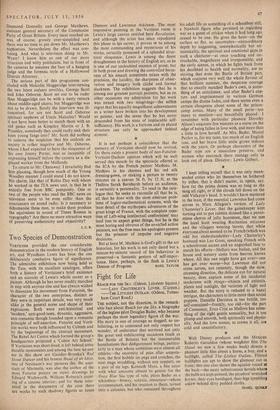Two Species of Demonstration
VORTICISM provided the one considerable demonstration in the modern history of English art, and Wyndham Lewis has been the one deliberately combative figure of significance. The admirable exhibition now being held at the Tate, with its excellent catalogue, offers both a history of Vorticism's brief existence and an account of Lewis's whole career as a Painter. Although he has never readily marched in step with anyone else and has always wished to dissociate his movement from Futurism, the character of the two enterprises, distinct as they were in important details, was very much alike in the general noise and shape of their explosions. Both were anti-historical and 'modern,' anti-good-taste, dynamic, aggressive, anti-romantic though founded upon a romantic Principle of self-assertion. Futurist and Vorti- cist works were both influenced by Cubism and by the beginnings of the abstract movement. The Rebel Art Ce--itre which formed the group's headquarters projected a 'Cubist Art School.' If Vorticism was short-lived, it left behind some durable monuments and among the best we can see in this show are Gaudier-Brzcska's Red Stone Dancer and his bronze Head of an Idiot, two of Nevinson's war pictures (he, the asso- ciate of Marinetti, was also the author of the most Futurist picture on view), drawings by Edward Wadsworth, William Roberts's paint- , ing of a cinema interior; and for those inter- ested in the documents of the case there are works by such shadowy figures as Jessie Dismorr and Lawrence Atkinson. The most impressive painting in the Vorticist room is Lewis's large canvas entitled here Revolution, and although the artist has since repudiated this phase in kis career, it proves to be among the most commanding and mysterious of his works, certainly possessed of a splendid struc- tural eloquence. Lewis is among the finest draughtsmen in the history of English art, as he is one of our undoubted masters of prose, but in both prose and drawing the controlled fierce- ness of his assault sometimes Mixes with the precision, the lucidity, the sharpness of obser- vation and imagery both cliché and formal slackness. The exhibition suggests that he is among our greatest portrait painters, but as on other occasions my admiration for his work was mixed with two misgivings—the selfish regret that his equally magnificent achievements as a writer have broken into his development as painter, and the sense that he has never descended from his state of implacable self- sufficiency. His work is a fortress and its plated structure can only be approached behind armour.
It is not perhaps a coincidence that the memory of Vorticism should now be revived, for there exists a present body of neo-Futurist- Vorticist-Dadaist opinion which will be well served this month by the spectacle offered at the 1CA by the French painter Mathieu. Mathieu in his chateau and his red silk dressing-gown, or making a picture in twenty minutes on a canvas 36 ft. by 12 ft. at the Theatre Sarah Bernhardt before an audience, is certainly a personality. To read in the cata- logue that 'he seeks to reconcile all that he is, all that he does with the most abstruse prob- lems of logico-mathematical systems, with the least detail of the mythopteic adventures of the great kings of France, with the complete rejec- tion of Left-wing intellectual conformism' may lead you to expect great things, but he is the most boring and obvious of the so-called action painters, not the free man his apologists present but the prisoner of impulse and negative decisions.
But at least M. Mathieu is God's gift to the art historian, for his work is not only dated but a minute-by-minute record of his behaviour is preserved—a fantastic gesture of self-impor- tance. Here, perhaps, in the flesh is Lewis's


































 Previous page
Previous page